吴裕雄 python 机器学习——集成学习梯度提升决策树GradientBoostingRegressor回归模型
import numpy as np
import matplotlib.pyplot as plt from sklearn import datasets,ensemble
from sklearn.model_selection import train_test_split def load_data_regression():
'''
加载用于回归问题的数据集
'''
#使用 scikit-learn 自带的一个糖尿病病人的数据集
diabetes = datasets.load_diabetes()
# 拆分成训练集和测试集,测试集大小为原始数据集大小的 1/4
return train_test_split(diabetes.data,diabetes.target,test_size=0.25,random_state=0) #集成学习梯度提升决策树GradientBoostingRegressor回归模型
def test_GradientBoostingRegressor(*data):
X_train,X_test,y_train,y_test=data
regr=ensemble.GradientBoostingRegressor()
regr.fit(X_train,y_train)
print("Training score:%f"%regr.score(X_train,y_train))
print("Testing score:%f"%regr.score(X_test,y_test)) # 获取分类数据
X_train,X_test,y_train,y_test=load_data_regression()
# 调用 test_GradientBoostingRegressor
test_GradientBoostingRegressor(X_train,X_test,y_train,y_test)

def test_GradientBoostingRegressor_num(*data):
'''
测试 GradientBoostingRegressor 的预测性能随 n_estimators 参数的影响
'''
X_train,X_test,y_train,y_test=data
nums=np.arange(1,200,step=2)
fig=plt.figure()
ax=fig.add_subplot(1,1,1)
testing_scores=[]
training_scores=[]
for num in nums:
regr=ensemble.GradientBoostingRegressor(n_estimators=num)
regr.fit(X_train,y_train)
training_scores.append(regr.score(X_train,y_train))
testing_scores.append(regr.score(X_test,y_test))
ax.plot(nums,training_scores,label="Training Score")
ax.plot(nums,testing_scores,label="Testing Score")
ax.set_xlabel("estimator num")
ax.set_ylabel("score")
ax.legend(loc="lower right")
ax.set_ylim(0,1.05)
plt.suptitle("GradientBoostingRegressor")
plt.show() # 调用 test_GradientBoostingRegressor_num
test_GradientBoostingRegressor_num(X_train,X_test,y_train,y_test)
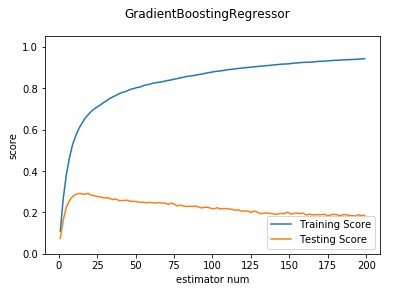
def test_GradientBoostingRegressor_maxdepth(*data):
'''
测试 GradientBoostingRegressor 的预测性能随 max_depth 参数的影响
'''
X_train,X_test,y_train,y_test=data
maxdepths=np.arange(1,20)
fig=plt.figure()
ax=fig.add_subplot(1,1,1)
testing_scores=[]
training_scores=[]
for maxdepth in maxdepths:
regr=ensemble.GradientBoostingRegressor(max_depth=maxdepth,max_leaf_nodes=None)
regr.fit(X_train,y_train)
training_scores.append(regr.score(X_train,y_train))
testing_scores.append(regr.score(X_test,y_test))
ax.plot(maxdepths,training_scores,label="Training Score")
ax.plot(maxdepths,testing_scores,label="Testing Score")
ax.set_xlabel("max_depth")
ax.set_ylabel("score")
ax.legend(loc="lower right")
ax.set_ylim(-1,1.05)
plt.suptitle("GradientBoostingRegressor")
plt.show() # 调用 test_GradientBoostingRegressor_maxdepth
test_GradientBoostingRegressor_maxdepth(X_train,X_test,y_train,y_test)

def test_GradientBoostingRegressor_learning(*data):
'''
测试 GradientBoostingRegressor 的预测性能随 learning_rate 参数的影响
'''
X_train,X_test,y_train,y_test=data
learnings=np.linspace(0.01,1.0)
fig=plt.figure()
ax=fig.add_subplot(1,1,1)
testing_scores=[]
training_scores=[]
for learning in learnings:
regr=ensemble.GradientBoostingRegressor(learning_rate=learning)
regr.fit(X_train,y_train)
training_scores.append(regr.score(X_train,y_train))
testing_scores.append(regr.score(X_test,y_test))
ax.plot(learnings,training_scores,label="Training Score")
ax.plot(learnings,testing_scores,label="Testing Score")
ax.set_xlabel("learning_rate")
ax.set_ylabel("score")
ax.legend(loc="lower right")
ax.set_ylim(-1,1.05)
plt.suptitle("GradientBoostingRegressor")
plt.show() # 调用 test_GradientBoostingRegressor_learning
test_GradientBoostingRegressor_learning(X_train,X_test,y_train,y_test)
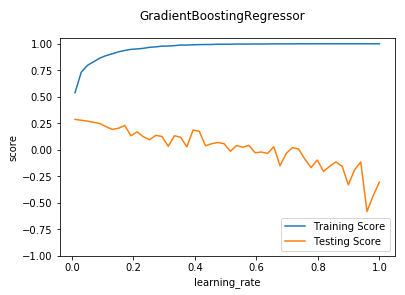
def test_GradientBoostingRegressor_subsample(*data):
'''
测试 GradientBoostingRegressor 的预测性能随 subsample 参数的影响
'''
X_train,X_test,y_train,y_test=data
fig=plt.figure()
ax=fig.add_subplot(1,1,1)
subsamples=np.linspace(0.01,1.0,num=20)
testing_scores=[]
training_scores=[]
for subsample in subsamples:
regr=ensemble.GradientBoostingRegressor(subsample=subsample)
regr.fit(X_train,y_train)
training_scores.append(regr.score(X_train,y_train))
testing_scores.append(regr.score(X_test,y_test))
ax.plot(subsamples,training_scores,label="Training Score")
ax.plot(subsamples,testing_scores,label="Training Score")
ax.set_xlabel("subsample")
ax.set_ylabel("score")
ax.legend(loc="lower right")
ax.set_ylim(-1,1.05)
plt.suptitle("GradientBoostingRegressor")
plt.show() # 调用 test_GradientBoostingRegressor_subsample
test_GradientBoostingRegressor_subsample(X_train,X_test,y_train,y_test)
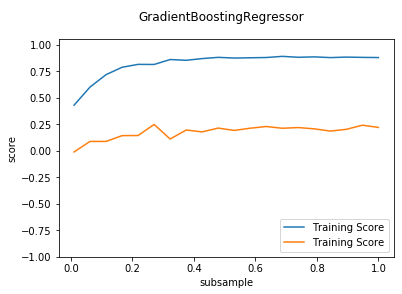
def test_GradientBoostingRegressor_loss(*data):
'''
测试 GradientBoostingRegressor 的预测性能随不同的损失函数和 alpha 参数的影响
'''
X_train,X_test,y_train,y_test=data
fig=plt.figure()
nums=np.arange(1,200,step=2)
########## 绘制 huber ######
ax=fig.add_subplot(2,1,1)
alphas=np.linspace(0.01,1.0,endpoint=False,num=5)
for alpha in alphas:
testing_scores=[]
training_scores=[]
for num in nums:
regr=ensemble.GradientBoostingRegressor(n_estimators=num,loss='huber',alpha=alpha)
regr.fit(X_train,y_train)
training_scores.append(regr.score(X_train,y_train))
testing_scores.append(regr.score(X_test,y_test))
ax.plot(nums,training_scores,label="Training Score:alpha=%f"%alpha)
ax.plot(nums,testing_scores,label="Testing Score:alpha=%f"%alpha)
ax.set_xlabel("estimator num")
ax.set_ylabel("score")
ax.legend(loc="lower right",framealpha=0.4)
ax.set_ylim(0,1.05)
ax.set_title("loss=%huber")
plt.suptitle("GradientBoostingRegressor")
#### 绘制 ls 和 lad
ax=fig.add_subplot(2,1,2)
for loss in ['ls','lad']:
testing_scores=[]
training_scores=[]
for num in nums:
regr=ensemble.GradientBoostingRegressor(n_estimators=num,loss=loss)
regr.fit(X_train,y_train)
training_scores.append(regr.score(X_train,y_train))
testing_scores.append(regr.score(X_test,y_test))
ax.plot(nums,training_scores,label="Training Score:loss=%s"%loss)
ax.plot(nums,testing_scores,label="Testing Score:loss=%s"%loss)
ax.set_xlabel("estimator num")
ax.set_ylabel("score")
ax.legend(loc="lower right",framealpha=0.4)
ax.set_ylim(0,1.05)
ax.set_title("loss=ls,lad")
plt.suptitle("GradientBoostingRegressor")
plt.show() # 调用 test_GradientBoostingRegressor_loss
test_GradientBoostingRegressor_loss(X_train,X_test,y_train,y_test)
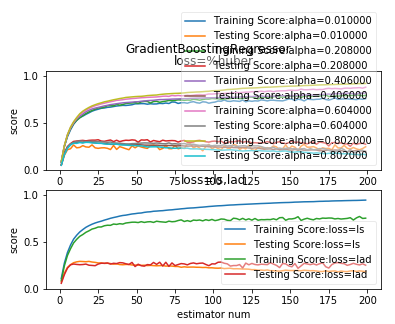
def test_GradientBoostingRegressor_max_features(*data):
'''
测试 GradientBoostingRegressor 的预测性能随 max_features 参数的影响
'''
X_train,X_test,y_train,y_test=data
fig=plt.figure()
ax=fig.add_subplot(1,1,1)
max_features=np.linspace(0.01,1.0)
testing_scores=[]
training_scores=[]
for features in max_features:
regr=ensemble.GradientBoostingRegressor(max_features=features)
regr.fit(X_train,y_train)
training_scores.append(regr.score(X_train,y_train))
testing_scores.append(regr.score(X_test,y_test))
ax.plot(max_features,training_scores,label="Training Score")
ax.plot(max_features,testing_scores,label="Training Score")
ax.set_xlabel("max_features")
ax.set_ylabel("score")
ax.legend(loc="lower right")
ax.set_ylim(0,1.05)
plt.suptitle("GradientBoostingRegressor")
plt.show() # 调用 test_GradientBoostingRegressor_max_features
test_GradientBoostingRegressor_max_features(X_train,X_test,y_train,y_test)
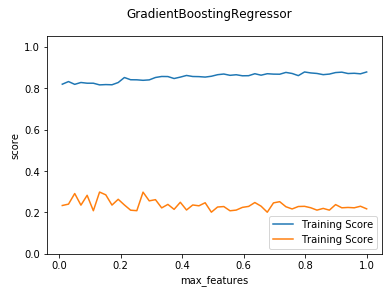
吴裕雄 python 机器学习——集成学习梯度提升决策树GradientBoostingRegressor回归模型的更多相关文章
- 吴裕雄 python 机器学习——集成学习随机森林RandomForestRegressor回归模型
import numpy as np import matplotlib.pyplot as plt from sklearn import datasets,ensemble from sklear ...
- 吴裕雄 python 机器学习——集成学习随机森林RandomForestClassifier分类模型
import numpy as np import matplotlib.pyplot as plt from sklearn import datasets,ensemble from sklear ...
- 吴裕雄 python 机器学习——集成学习AdaBoost算法回归模型
import numpy as np import matplotlib.pyplot as plt from sklearn import datasets,ensemble from sklear ...
- 吴裕雄 python 机器学习——集成学习AdaBoost算法分类模型
import numpy as np import matplotlib.pyplot as plt from sklearn import datasets,ensemble from sklear ...
- 吴裕雄 python 机器学习——数据预处理字典学习模型
from sklearn.decomposition import DictionaryLearning #数据预处理字典学习DictionaryLearning模型 def test_Diction ...
- 吴裕雄 python 机器学习——人工神经网络感知机学习算法的应用
import numpy as np from matplotlib import pyplot as plt from sklearn import neighbors, datasets from ...
- 吴裕雄 python 机器学习——人工神经网络与原始感知机模型
import numpy as np from matplotlib import pyplot as plt from mpl_toolkits.mplot3d import Axes3D from ...
- 吴裕雄 python 机器学习——分类决策树模型
import numpy as np import matplotlib.pyplot as plt from sklearn import datasets from sklearn.model_s ...
- 吴裕雄 python 机器学习——回归决策树模型
import numpy as np import matplotlib.pyplot as plt from sklearn import datasets from sklearn.model_s ...
随机推荐
- D - Three Integers
https://codeforces.com/contest/1311/problem/D 本题题意:给出a,b,c三个数,a<=b<=c: 可以对三个数中任意一个进行+1或-1的操作: ...
- 简单的登录验证小程序_python
一.要求 输入用户名密码,验证成功之后显示欢迎信息,输错三次后锁定. 程序: #!/usr/bin/env python# _*_ coding:utf-8 _*_#Author:chenxz #将黑 ...
- python创建字典的三种方式
创建空字典: dict_eq={} print(type(dict)) 直接赋值创建字典: dict_eq={'a':1,'b':2,'c':'adbc'} 通过关键字dict和关键字参数创建 dic ...
- 【Python】圆周率的计算
1.公式法 代码: #CalPiV1.py pi=0 N=100 for k in range(N): pi+=1/pow(16,k)*(\ 4/(8*k+1)-2/(8*k+4)-\ 1/(8*k ...
- many connection errors,更改max_connection_errors的值
https://www.cnblogs.com/tonyccc/p/11496101.html https://blog.csdn.net/li_li_lin/article/details/7276 ...
- WSO2 ESB XML定义语法(3)
6.Property Mediator 通过Synapse调解的每条消息都可以具有一组关联的属性.Synapse引擎和底层传输在处理的每条消息上设置了许多属性,用户可以操纵这些属性来修改消息流的运行时 ...
- Windows ThinPC 7 部署后续设置与本地化
还原注销背景 %system32%\oobe\info\backgrounds 删除该目录下所有文件后变为wes7背景 24时制与非UNICODE字符乱码解决 Control Panel \ Regi ...
- Grafana展示zabbix监控数据
一.安装步骤 (1)进入官网选择合适的操作系统版本下载Grafana:https://grafana.com/grafana/download?platform=linux [root@zabbix- ...
- war文件—Web项目部署
war文件是什么? Web存档(war)文件包含Web应用程序的所有内容.它减少了传输文件所需要的时间. war文件的优点 节省时间:war文件将所有文件合并为一个单位. 所以在将文件从客户端传输到 ...
- Redis Bitmap
Redis提供对字符串的按位操作,位图把字符串抽象成一个bool类型的数组,可以进行按位操作 比如说我有一个字符串“a” 那他的位图如下 (位) 7 6 5 4 3 2 1 0 (值) 0 1 0 ...
